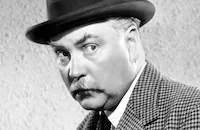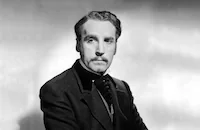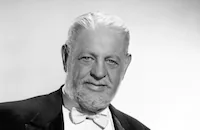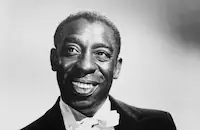Sherlock Holmes in Washington
Brief Synopsis
Cast & Crew
Roy William Neill
Basil Rathbone
Nigel Bruce
Marjorie Lord
Henry Daniell
George Zucco
Film Details
Technical Specs

Synopsis
British diplomat Sir Henry Marchmont travels on a transatlantic flight from London to New York, on his way to Washington, D.C. He is followed by a group of German spies, led by William Easter, who suspect that Sir Henry is carrying secret government documents. The German agents later learn that Sir Henry is merely a decoy, and Easter recognizes that fellow passenger John Grayson is the actual courier. Realizing that he has been discovered, Grayson slips a matchbook into the purse of socialite Nancy Partridge just moments before he is abducted by Easter and his men. Back in London, famed detective Sherlock Holmes and his companion, Dr. John Watson, learn from Mr. Ahrens of the British Home Office that Grayson was actually secret service agent Alfred Pettibone, and Holmes is asked to recover the vital secret documents. The detective soon deduces that Grayson photographed the documents, then placed the microfilm in an American matchbook folder. Arriving in Washington, Holmes and Watson are met by Bart Lang of the British embassy and Detective Lt. Grogan of the Washington police department, the officer in charge of the Grayson case. Grayson's murdered body is later delivered to Holmes's hotel room, and the detective deduces from inspecting it that the spies have not found the secret documents. After interviewing George, a train porter, Holmes quickly surmises that Nancy has the matchbook. Easter comes to a similar conclusion, so he arranges for his men to attend Nancy's engagement party. The spies abduct both Nancy and her fiancé, naval lieutenant Peter Merriam, then remove Nancy, hidden inside a rolled-up carpet, from her aunt's home. Without any other leads, Holmes examines the materials found with Grayson's body and deduces that Nancy's kidnappers work in an antique shop. He and Watson then probe Washington's antique shops, finally arriving at Stanley's Antiques, which Holmes correctly suspects is the spies's hideout. Inside, Richard Stanley, the owner, questions Nancy about the secret documents, of which she truthfully claims no knowledge. Pretending to be an eccentric collector, Holmes gains admittance into Stanley's office, whom he immediately recognizes as Heinrich Hinkle, an ex-secret agent for pre-war Germany, who now heads an international spy ring. Stanley recognizes Holmes as well, but is unaware that he is lighting Holmes's cigarette with the very matchbook that holds the microfilm. Stanley's men capture Holmes, but before the spy can have the detective and Nancy executed, Watson arrives with Peter and the police. Stanley manages to escape through a secret passageway, however, and heads straight for the office of Senator Henry Babcock, who he has learned from Holmes holds a stamped envelope given to him by Grayson during the train ride to Washington, which the detective has led the spy to believe contains the microfilm. Stanley walks straight into Holmes's trap, and the microfilm is safely recovered. Holmes then reminds Stanley that he had told him that the man who had the secret documents did not know he had it, as Stanley had been carrying the matchbook since his abduction of Nancy.

Director
Roy William Neill
Cast

Basil Rathbone

Nigel Bruce

Marjorie Lord

Henry Daniell

George Zucco

John Archer
Gavin Muir
Edmund Macdonald
Don Terry

Bradley Page

Holmes Herbert

Thurston Hall

Gilbert Emery

Ian Wolfe
Mary Forbes
Gerald Hamer
John Burton
Regina Wallace
Mary Gordon
Margaret Seddon
Alice Fleming

Clarence Muse
Leyland Hodgson
Evelyn Cooke
Charles Marsh
Gene O'donnell
Alexander Lockwood
Eddie Coke
Paul Scott
Lee Shumway
Irving Mitchell
Leslie Denison
Phil Warren
Tom Martin
Caroline Cooke
Kernan Cripps
Crew
Howard Benedict
Bernard B. Brown
R. A. Gausman
Otto Ludwig
James Masterson
Tom Mcknight
Bertram Millhauser
Bertram Millhauser
Martin Obzina
Jack Otterson
Charles Previn
Lynn Riggs
E. R. Robinson
Frank Skinner
William Tummel
Gilbert Valle
Vera West
Les White

Film Details
Technical Specs

Articles
Sherlock Holmes in Washington
Sherlock Holmes in Washington was the fifth of fourteen pictures in the popular Sherlock Holmes film series starring Basil Rathbone in the title role. 20th Century Fox had begun the series in 1939 with The Hound of the Baskervilles, but after two films Universal took over the rights. Universal modernized the series, bringing Sherlock Holmes out of Victorian London and into the twentieth century. World War II was raging at the time, and the change allowed the studio to use the war as a topical backdrop to several of the Holmes films.
This entry into the series has the novelty of transporting Holmes from his British stomping grounds to the United States capital with a healthy dose of wartime patriotism thrown in for good measure. Sherlock Holmes in Washington also has the distinction of being the first film in the series that was not directly based on a story by Sir Arthur Conan Doyle.
Sherlock Holmes in Washington was directed by Roy William Neill, who contributed eleven Holmes films altogether to the series. The screenplay was written by Lynn Riggs and Bertram Millhauser. Riggs co-wrote one previous film in the series, Sherlock Holmes and the Voice of Terror (1942), while Millhauser went on to write several more series films on his own including Sherlock Holmes Faces Death (1943) and The Woman in Green (1945).
The team of Basil Rathbone and Nigel Bruce is, as always, a delight with the pair playing beautifully off one another with the drollest of humor. The supporting cast also sparkles, including Marjorie Lord as a kidnapped socialite and Henry Daniell and George Zucco as the film's villains. Both Daniell and Zucco portrayed Sherlock Holmes' arch nemesis Professor Moriarty in other films in the series - Daniell in The Woman in Green and Zucco in The Adventures of Sherlock Holmes (1939).
Sherlock Holmes in Washington received mostly positive critical reactions upon its release, with reviewers particularly praising the performances of Rathbone and Bruce. "What a public thinker, that Rathbone is! You can practically see the mighty muscles of his mind tense, grab, and get to the heart of the toughest mystery," said the New York Post. The Hollywood Reporter said, "Basil Rathbone is just what he should be in the title role, and Nigel Bruce is supplied with much bright comedy of which he is quick to make the most."
Producer: Roy William Neill (uncredited)
Director: Roy William Neill
Screenplay: Lynn Riggs; Bertram Millhauser (screenplay and story); Arthur Conan Doyle (characters)
Cinematography: Les White
Art Direction: Jack Otterson
Music: Frank Skinner
Film Editing: Otto Ludwig
Cast: Basil Rathbone (Sherlock Holmes), Nigel Bruce (Doctor Watson), Marjorie Lord (Nancy Partridge), Henry Daniell (William Easter), George Zucco (Stanley), John Archer (Lt. Pete Merriam), Gavin Muir (Mr. Lang - government agent), Edmund MacDonald (Detective Lt. Grogan), Don Terry (Howe), Bradley Page (Cady), Holmes Herbert (Mr. Ahrens), Thurston Hall (Senator Henry Babcock).
BW-71m.
by Andrea Passafiume

Sherlock Holmes in Washington
Quotes
I shall write a monograph someday on the noxious habit of accumulating useless trivia.- Sherlock Holmes
Trivia
Notes
The film opens with the following written foreword: "Sherlock Holmes, the immortal character of fiction created by Sir Arthur Conan Doyle, is ageless, invincible and unchanging. In solving significant problems of the present day he remains-as ever-the supreme master of deductive reasoning." Marjorie Lord's character is identified as "Nancy Pattridge" by the film's end credits; however, she is clearly called "Nancy Partridge" in the film and is listed that way in contemporary sources. This was the first Sherlock Holmes film in the Universal series that was not directly inspired by one of Sir Arthur Conan Doyle's stories. According to Hollywood Reporter news items, actress Evelyn Ankers was originally cast in the role of "Nancy Partridge." Hollywood Reporter news items also state that, as late as July 20, 1942, Robert Paige was being considered as John Archer's replacement in the role of "Lt. Peter Merriam." (Lord and Archer later married; actress Anne Archer is their daughter.) Actor George Zucco, who played "Robert Stanley" in the film, had previously appeared with Basil Rathbone and Nigel Bruce in the 1939 Twentieth-Century Fox Sherlock Holmes film The Adventures of Sherlock Holmes (see AFI Catalog of Feature Films, 1931-40: F3.0022), playing Holmes's arch nemesis, "Professor Moriarty." Screenwriter Bertram Millhauser, who would go on to write a number of the Universal films in the series, had previously written the 1932 Fox release Sherlock Holmes (see AFI Catalog of Feature Films, 1931-40: F3.4020). According to modern sources, the working title of this film was Sherlock Holmes in U.S.A. For further information on the series and other films featuring the Arthur Conan Doyle characters, consult the Series Index and see the above entry for Sherlock Holmes and the Voice of Terror, and the entries for Sherlock Holmes and The Hounds of the Baskervilles in the AFI Catalog of Feature Films, 1931-40 (F3.4020 and F3.2009).














